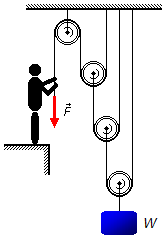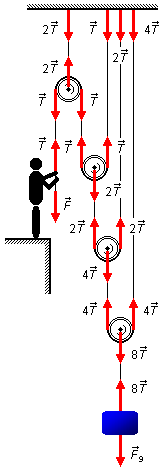Solved Problem on Dynamics
advertisement
A 12 kg mass body is suspended by a system of pulleys and cords, as shown in the figure, a man pulls the
rope with a force of 18 N. Assuming that the pulleys have no weight and there is no friction between the
pulleys and cords and they are inextensible and massless. Will the body rise or descend? What is
acceleration? The acceleration due to gravity is g = 10 m/s2.

Problem data:
- Mass of body: m=12 kg;
- Force applied by man: F= 18 N;
- Acceleration due to gravity: g=10 m/s2.
The force applied on the rope produces a tension force
\( \vec{T} \),
this is transferred by the cord to the other side of the pulley on the ceiling. This traction is
transmitted, by the rope passing through the second pulley (mobile), to the other side of the pulley, and
to balance these two tensions we have on the cord, which leaves the pulley, traction equal to
\( 2\vec{T} \).
This tension is now transmitted, by the rope that passes through the third pulley (also mobile), to the
other side of the pulley, and to balance these two tensions we have on the rope, which leaves this
pulley, a tension equal to
\( 4\vec{T} \).
This traction is now transmitted, by the rope that passes through the fourth pulley (also mobile), to the
other side of the pulley, and to balance these two traces we have on the rope, which leaves this pulley
and holds to the body, a tension equal to
\( 8\vec{T} \)
(Figure 1). A system of three mobile pulleys multiplies the force applied by 8.

Solution
We can write in the man's hand
\[
\begin{gather}
T=F \tag{I}
\end{gather}
\]
But the system multiplies the applied force F by 8
\[
\begin{gather}
F_{R}=8T \tag{II}
\end{gather}
\]
substituting the expression (I) into expression (II)
\[
\begin{gather}
F_{R}=8F\\
F_{R}=8\times 18\\
F_{R}=144\;\text{N}
\end{gather}
\]
The gravitational force is given by
\[ \bbox[#99CCFF,10px]
{F_{g}=mg}
\]
\[
\begin{gather}
F_{g}=12\times 10\\
F_{g}=120\;\text{N}
\end{gather}
\]
As the resultant force applied to the body is greater than the gravitational force,
the body is rising.
We chose the direction for the upward acceleration (Figure 2). Drawing a free-body diagram, we have the
forces that act on the body we apply the Newton's Second Law
\[ \bbox[#99CCFF,10px]
{\vec{F}=m\vec{a}}
\]

\[
\begin{gather}
F_{R}-F_{g}=ma\\
144-120=12a\\
12a=24\\
a=\frac{24}{12}
\end{gather}
\]
\[ \bbox[#FFCCCC,10px]
{a=2\;\text{m/s}^{2}}
\]
advertisement

Fisicaexe - Physics Solved Problems by Elcio Brandani Mondadori is licensed under a Creative Commons Attribution-NonCommercial-ShareAlike 4.0 International License .